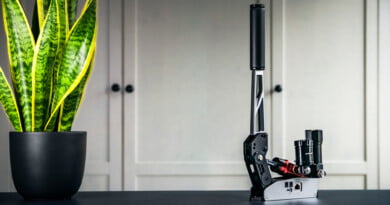Conspit FP-Lite Simrig
In Europe, Conspit isn’t yet a widely recognized name. However, Conspit is a significant player in simracing hardware, offering a diverse range of products for enthusiastic simracers. Based in Shanghai, China, they provide a variety of hardware, including pedals, cockpits, and accessories like lighting or a handbrake. We previously reviewed Conspit’s hydraulic pedal set and now have the opportunity to examine their Formula-style rig.
The FP-Lite, as this rig is called, is the lighter version of the two Formula rigs in Conspit’s “Formula Posture” series, which also includes the FP-Pro. At the time of writing, the Conspit FP-Lite sim rig starts at €749.00 excluding VAT. Depending on your location, there may be additional taxes and shipping costs. The sim rig we received includes a keyboard tray, a monitor stand, a mounting plate for a gear shifter or handbrake (referred to as the “manual bracket” by Conspit), and a small electric motor under the seat attachment.

Packaging & Contents
From the distribution center in Poland, the rig made its way to the Netherlands, arriving at our doorstep in two wooden crates weighing a hefty 77kg together. Fortunately, the contents of the crates are much lighter, but the rig still comes in a substantial box. In the first wooden crate, we found a large cardboard box with plastic corner protectors and sturdy cardboard L-profiles along the edges, ensuring maximum protection for the package. The second crate contained the seat, which was completely wrapped in a double layer of protective plastic film. It’s evident that Conspit goes to great lengths to ensure that your package is delivered to your door in excellent condition.
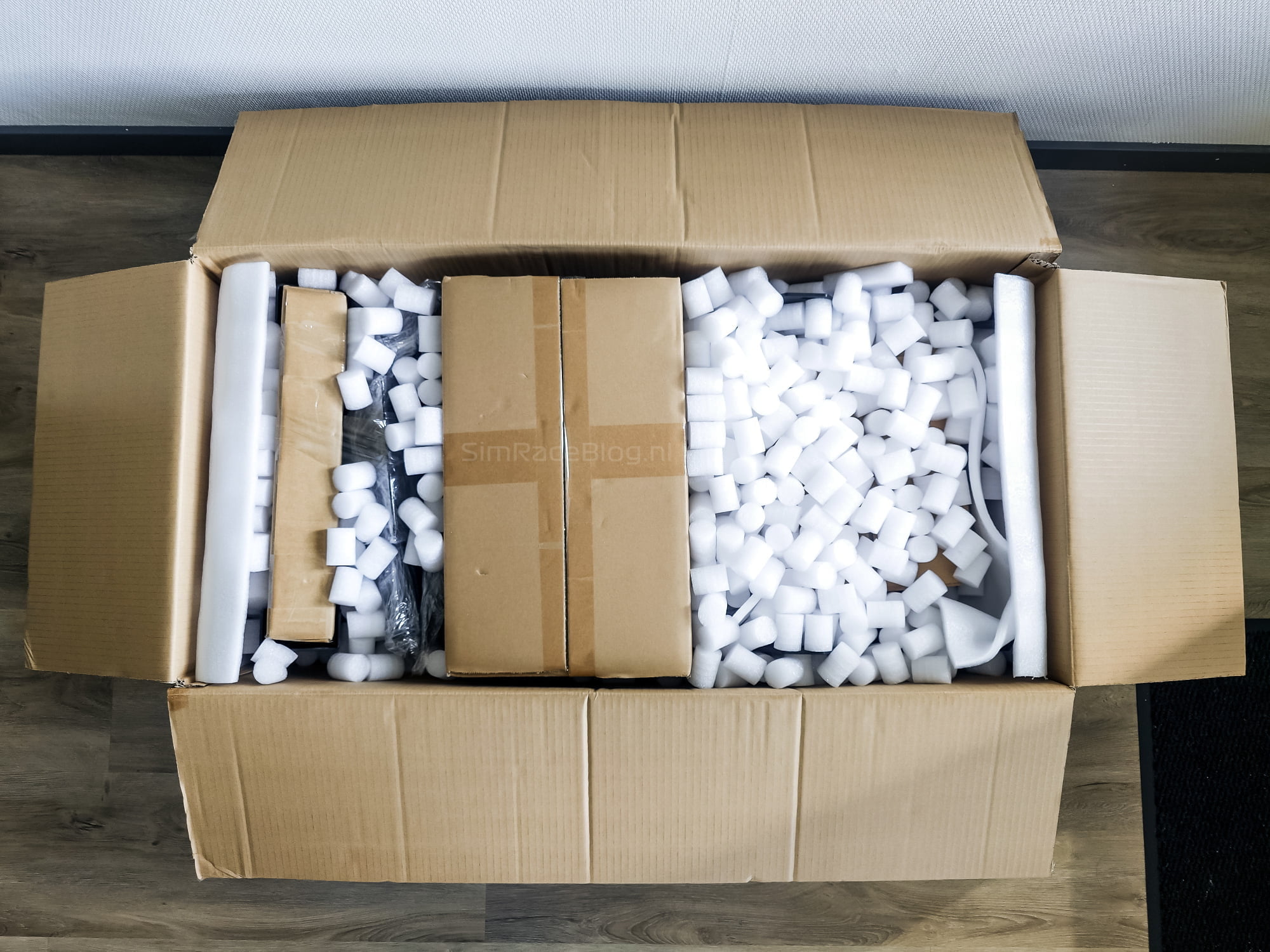
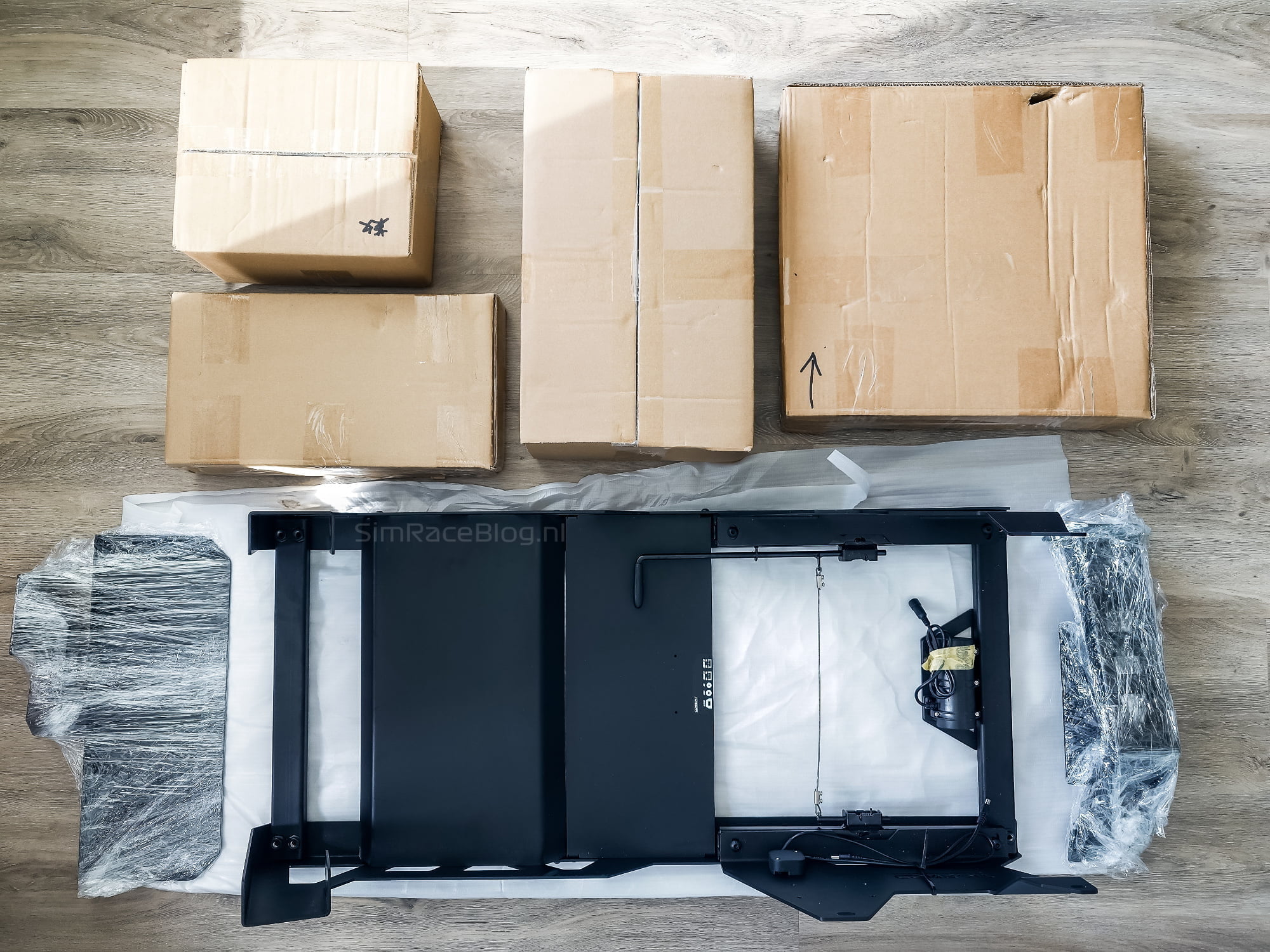
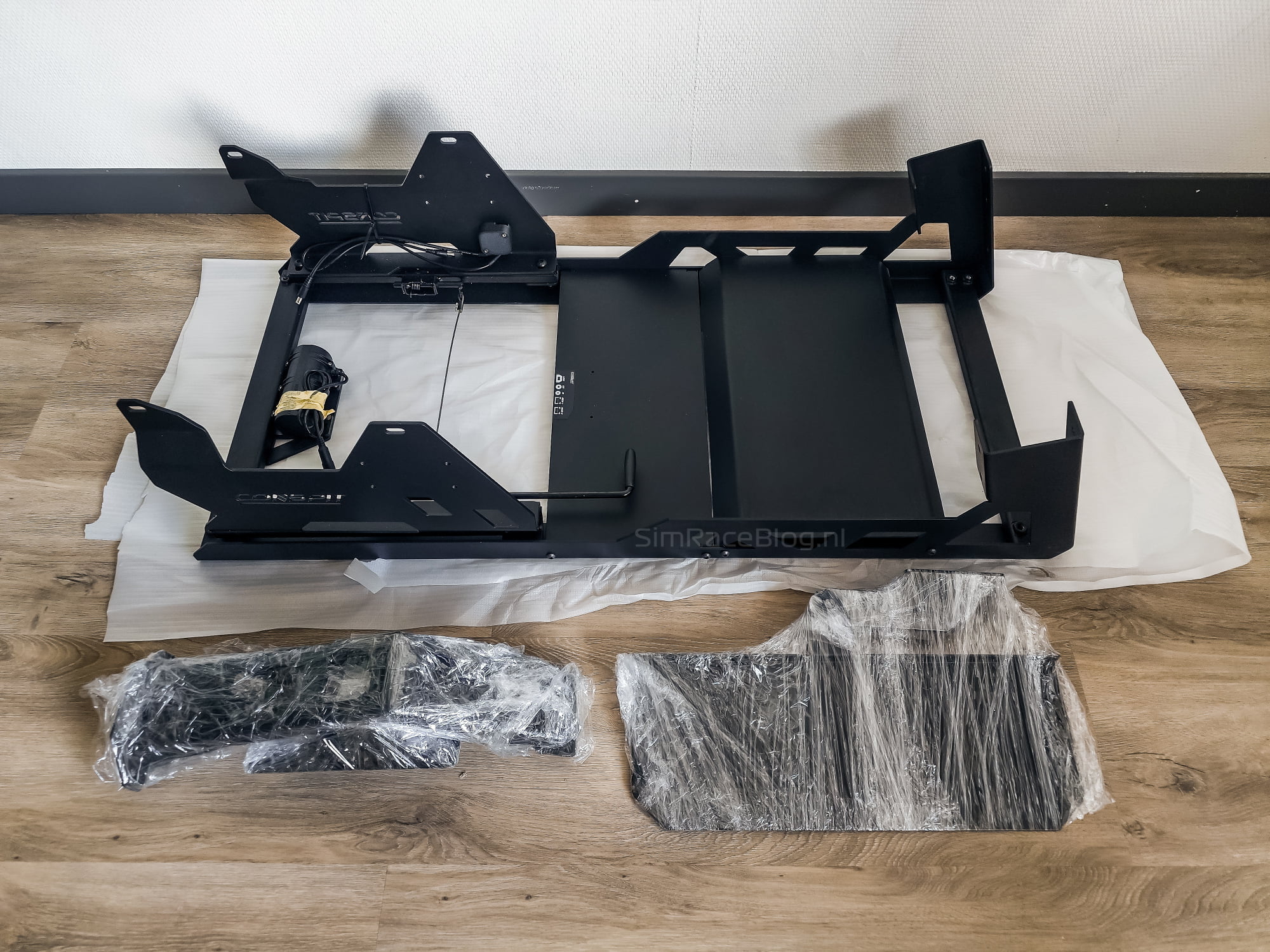

Upon opening the large cardboard box, we discovered it was packed to the brim with protective plastic flakes, from which we could extract numerous boxes and components. In this box, we found the base frame of the FP-Lite rig, a keyboard tray wrapped in plastic film, and separately packaged parts for the monitor mount. But that’s not all; we also discovered four more boxes, each containing specific contents. These boxes held parts for the wheel deck, mounting arms for the wheel deck, components for the pedal deck, and finally, a box containing all the necessary attachments, tools, cables, the manual bracket, the user manual, and a sheet of fun Conspit stickers.
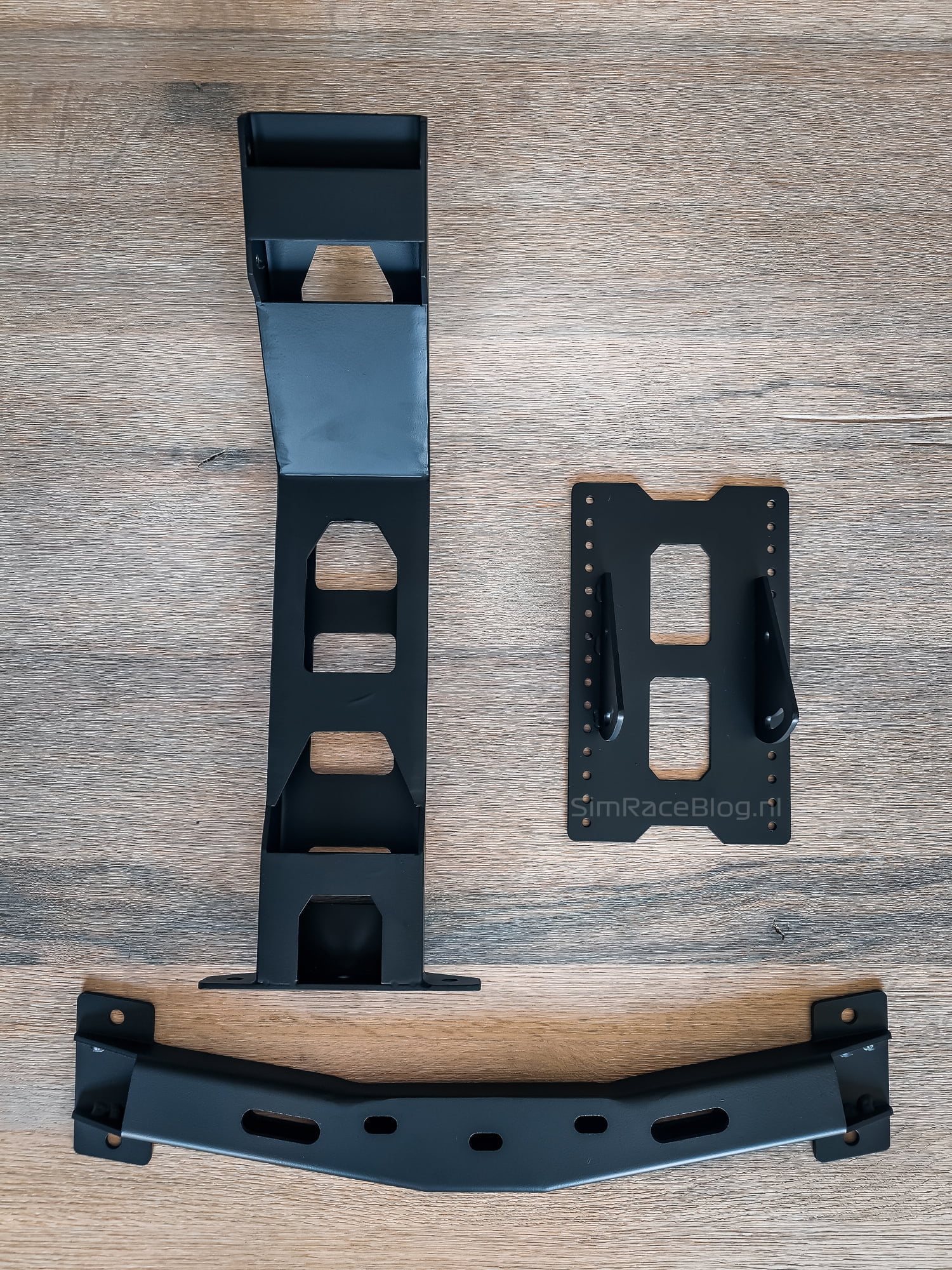
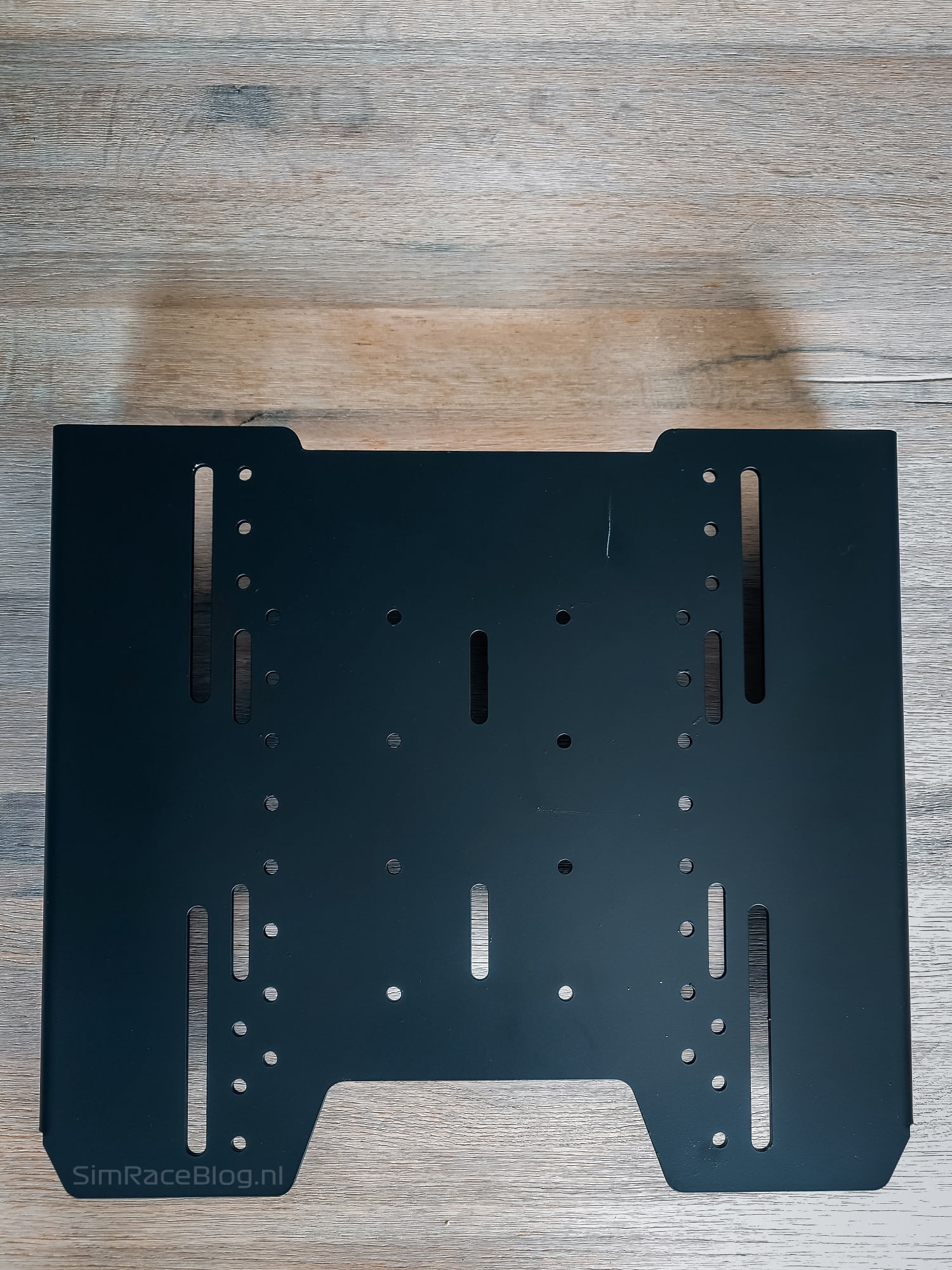

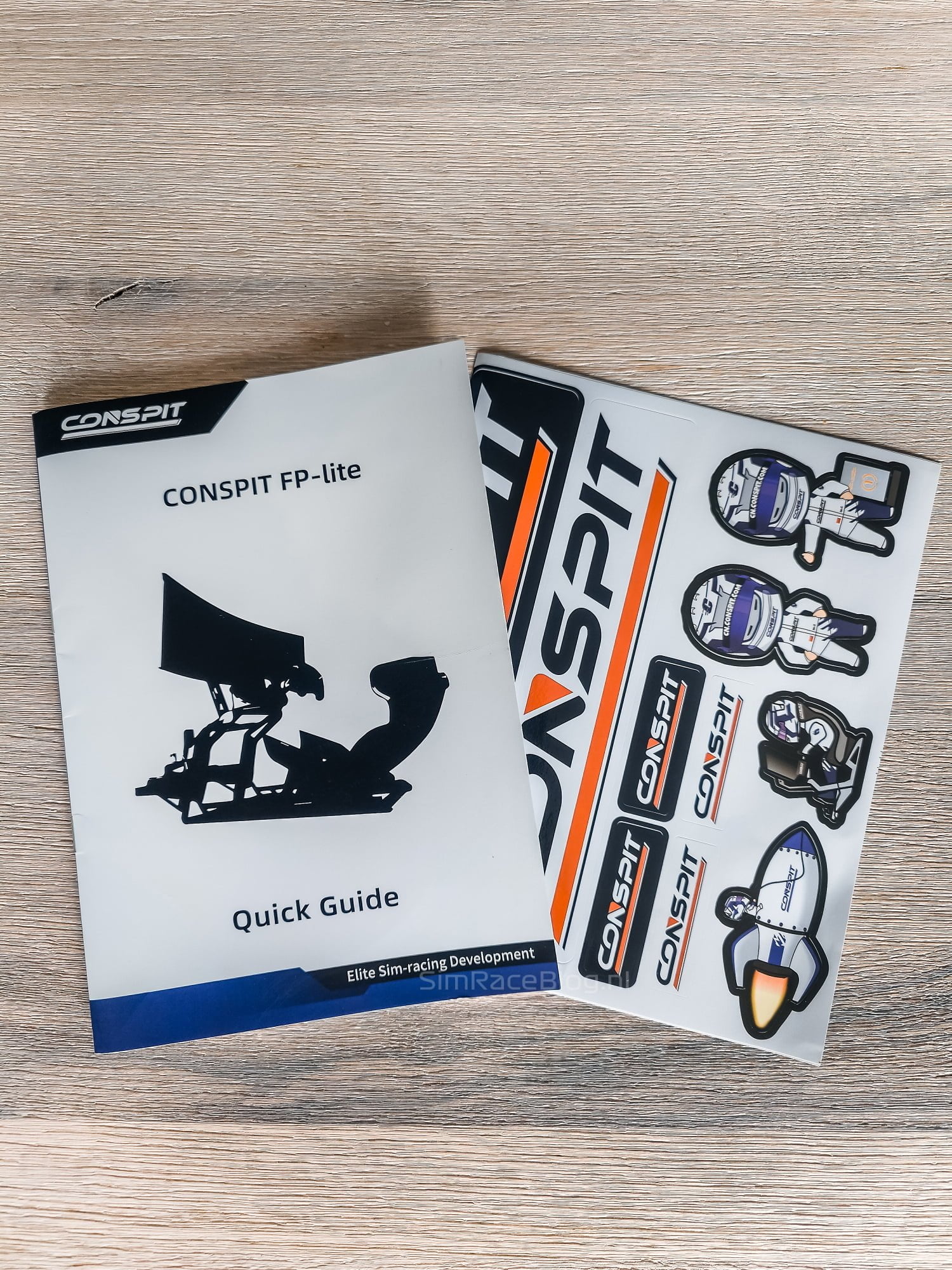
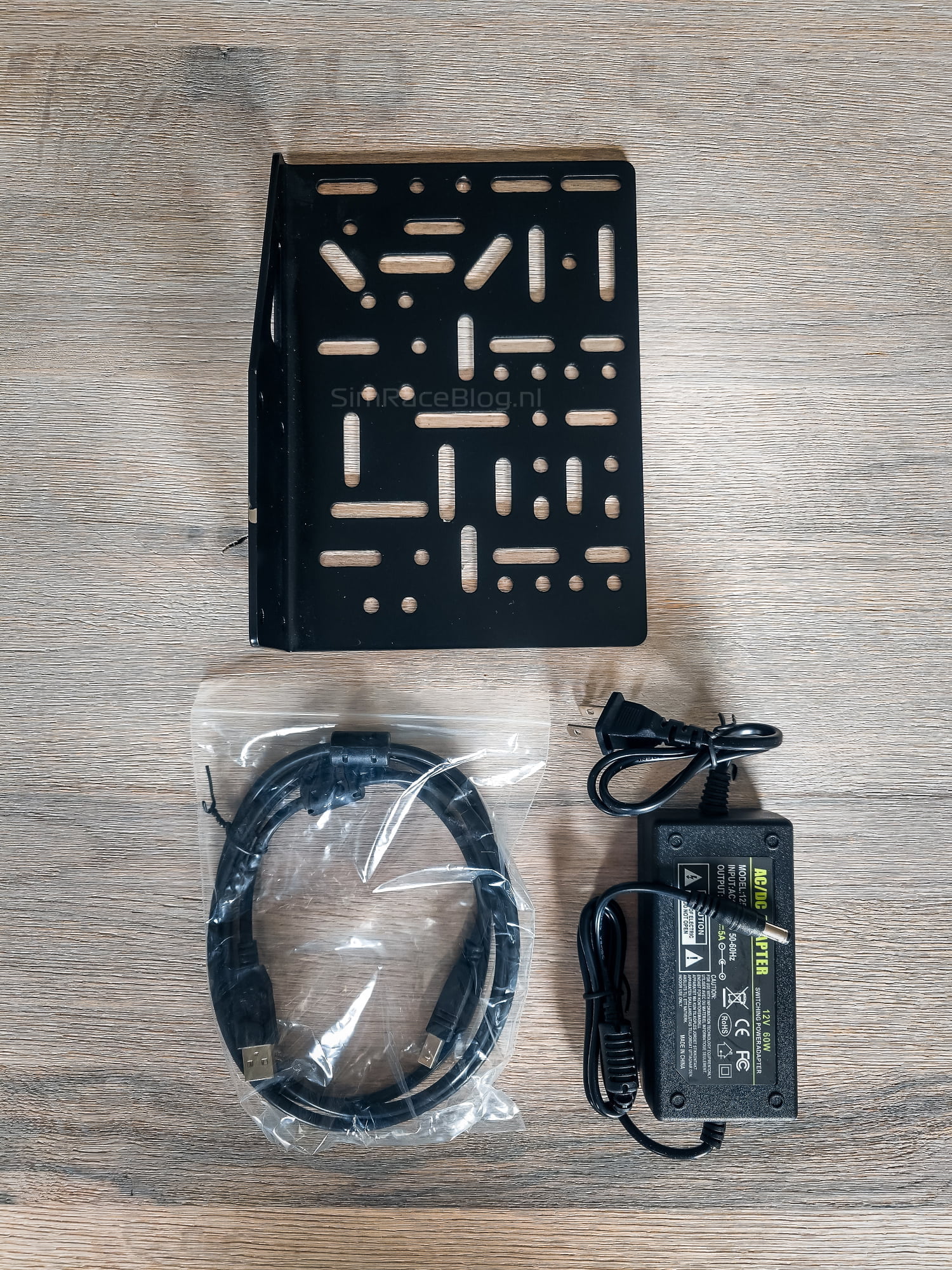

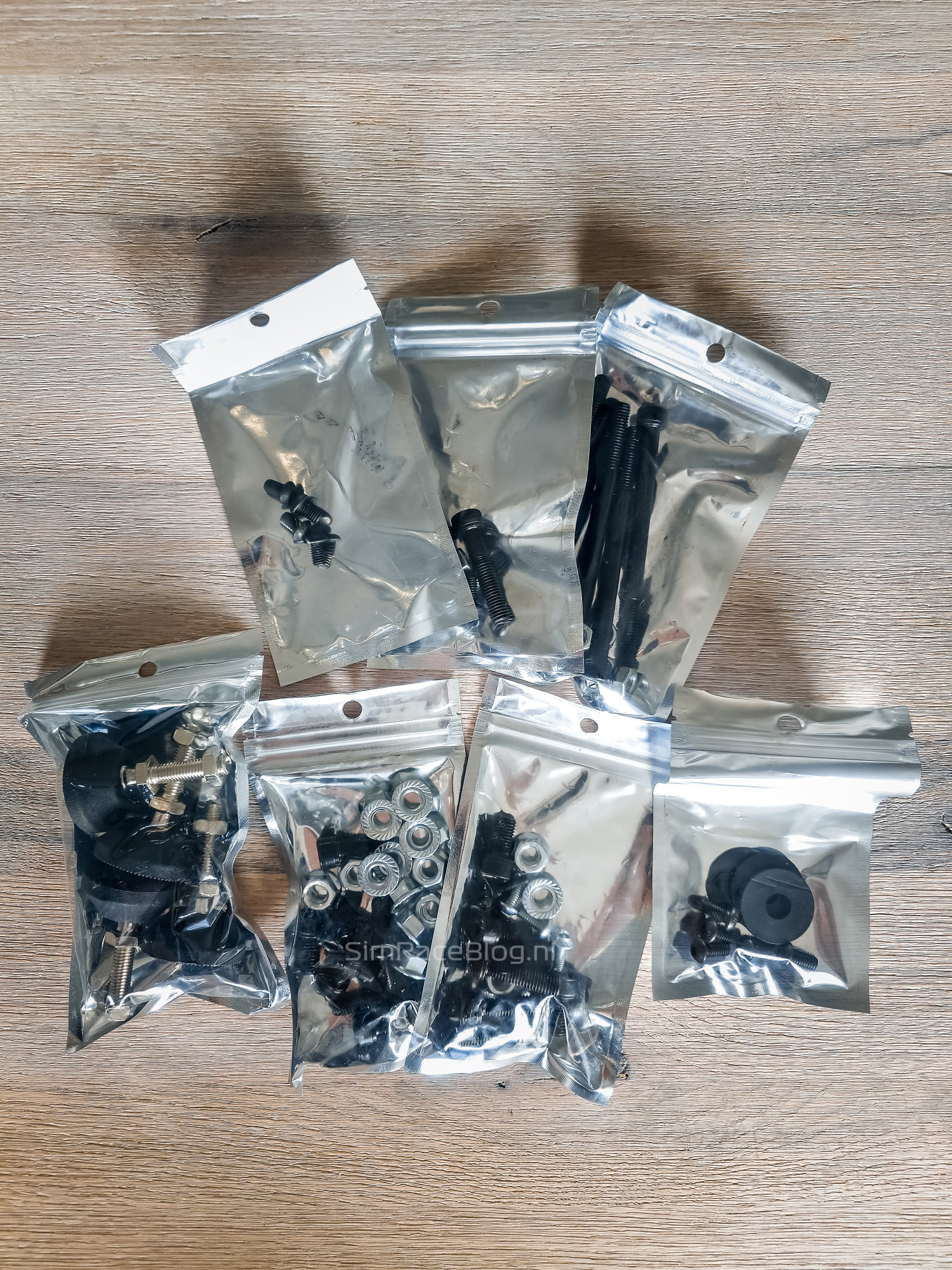
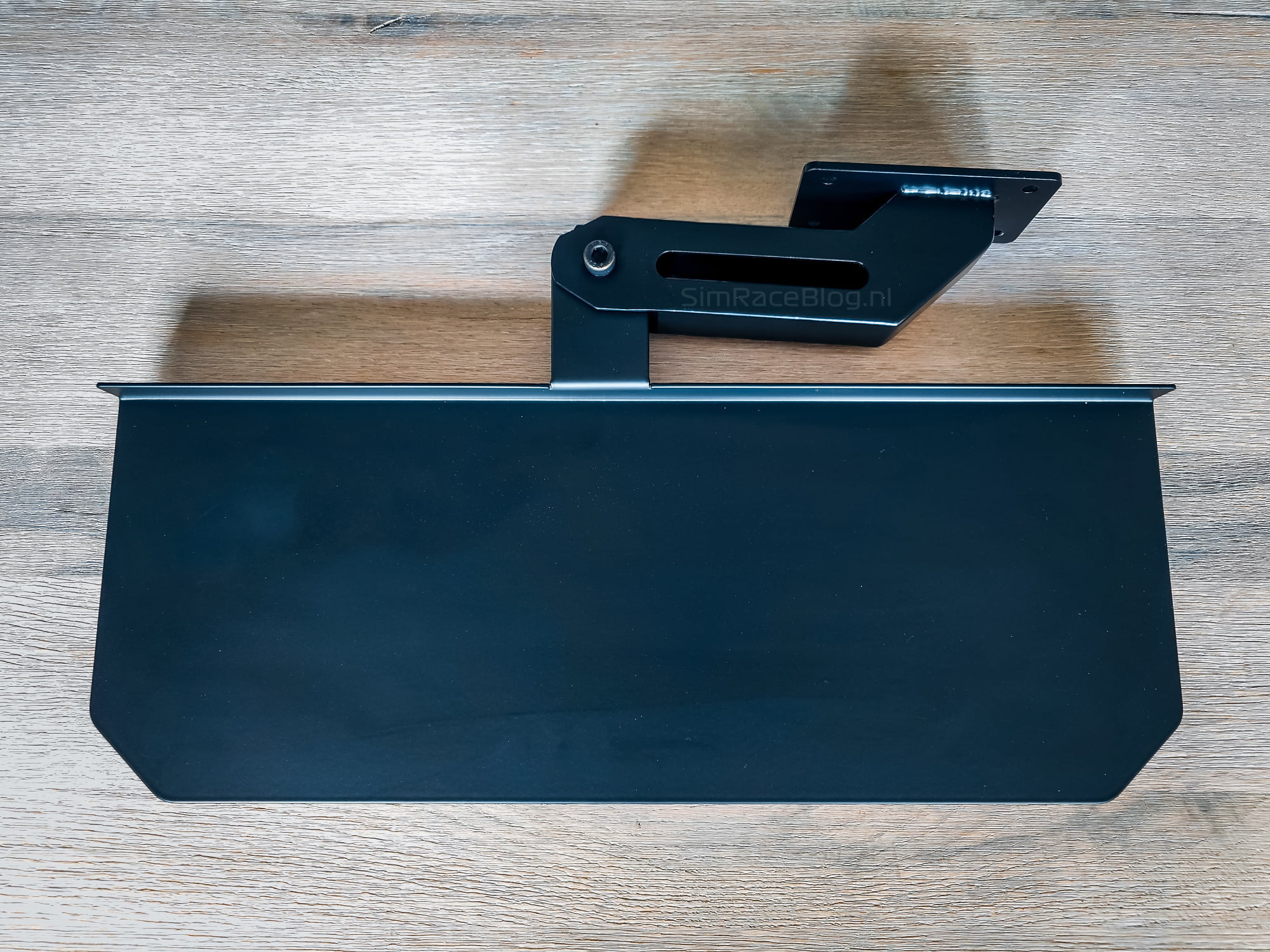

Engineering & Quality
In today’s market, most cockpits are made of aluminum profiles, but Conspit takes a different approach with the FP-Lite. This rig features a solid steel frame with adjustable elements. Both the base and the individual components are crafted from 3-4mm steel plates, coated with an electrostatically applied layer of paint for a sleek finish. The rig itself has a fairly compact size, measuring 170cm in length and 60cm in width, making it a space-friendly addition to your room.
The pedal deck consists of a single plate with pre-drilled holes and slots designed to support a wide range of pedals. This plate is attached to two slotted panels, allowing the pedal deck to be adjusted 11.5cm front to back and positioned at an angle ranging from 0 to 50 degrees. Conspit claims the pedal deck can handle a load of up to 200kg, making it suitable for heavy load cell pedals or hydraulic pedals.
The wheel deck of the FP-Lite rig also features a pre-drilled steel plate with a hole pattern compatible with most common wheelbases. It’s important to note that this flat plate supports only wheelbases that can be mounted from the bottom. However, this doesn’t compromise the strength of the wheel deck, as it should withstand the strongest wheelbases currently available, with a maximum allowable torque of 50Nm. The arms connecting to the wheel deck have holes, allowing for 10cm height adjustment in four steps. An added benefit of these arms is their hollow profile, enabling you to neatly conceal the wiring of your wheelbase and monitor within the rig. The angle of the pedal deck can be adjusted at the connection points with the arms, providing 15 degrees of continuous angle adjustment.
The seat provided with the FP-Lite by Conspit is a stylish formula bucket seat made of hard plastic material. Its interior boasts a matte black finish that feels comfortably soft to the touch, while the exterior features a glossy purple coating for a vibrant look. Notably, the seat has several slots, including one in the front between the legs, on both sides of the hip position, and two in the backrest beside the spine. These slots allow for the installation of a harness system, enhancing the immersive experience. On either side of the seat, there are threaded holes for attaching the seat to the rig’s base frame. The base frame features a sliding system with a lever, enabling you to adjust the seat over a length of 17.5cm. The entire system is robust enough to support simracers weighing up to 150kg.

Finally, there’s one special feature on the Conspit FP-Lite that can be added as an option. On the left mounting bracket of the seat, there is a rotary knob with seven different settings, connected to a small electric motor mounted under the seat. This is the M-DVF Vibration Module, where M-DVF stands for “Multi-Dynamic Vibration Feedback.” By connecting this module to the controller on the rig, it can be linked to your PC via a USB connection. After downloading the CONSPIT LINK software and the M-DVF firmware from the Conspit downloads page, you can customize its functionalities. You can activate the motor, for instance, when ABS or TC intervenes, when your wheels lock, or when you lose grip, offering a more immersive experience while simulating driving conditions.
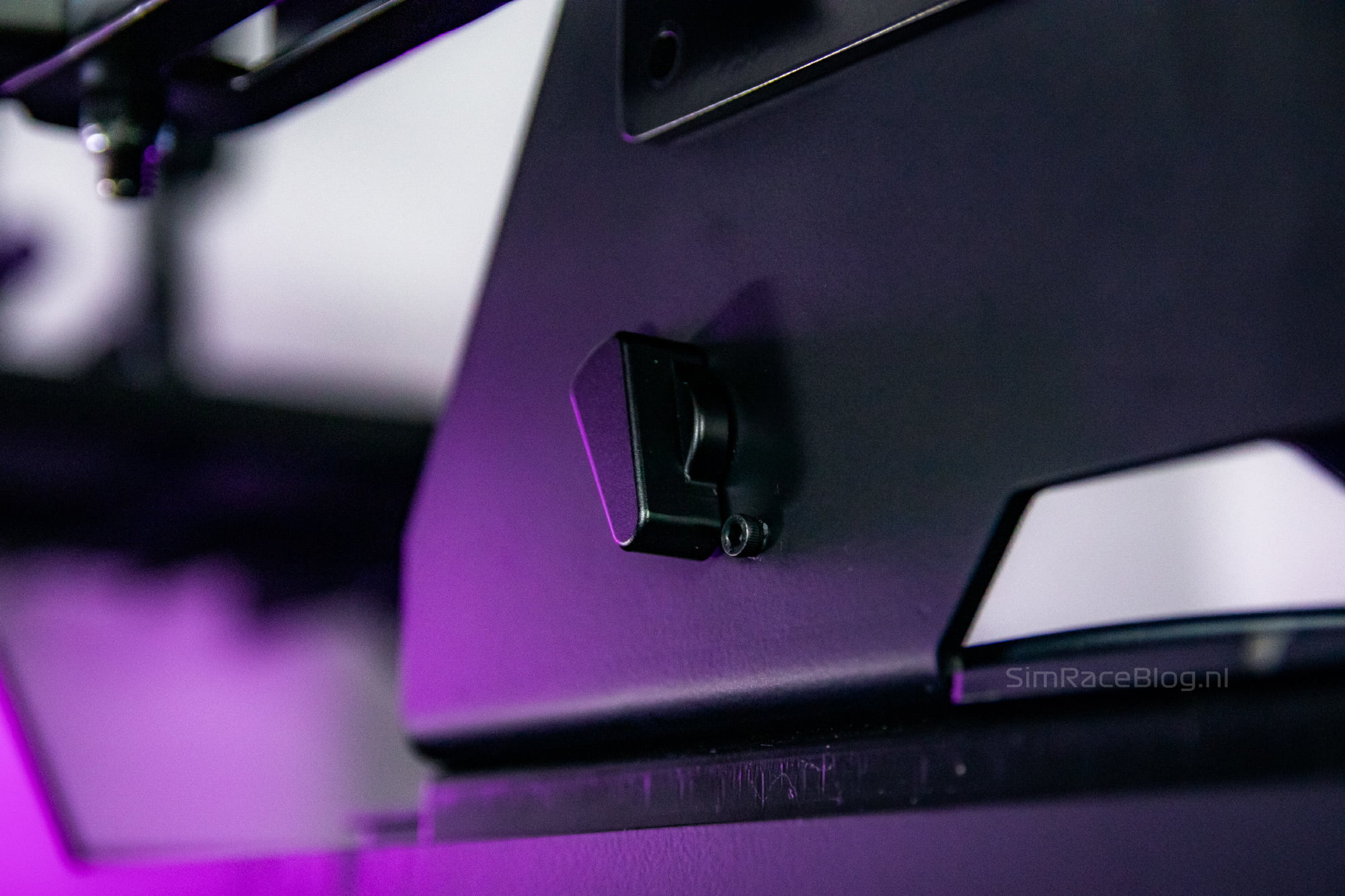
Assembly & Adjustment
Just as evident in the assembly process as it was in the shipping, Conspit demonstrates a strong commitment to ensuring a positive customer experience. Every detail of the assembly process is meticulously organized to provide a pleasant building experience. Each component’s mounting materials are neatly packaged in resealable bags, eliminating the hassle of searching for the right bolts and nuts. Plus, this thoughtful packaging makes it easy to store any leftover materials. Conspit also includes a comprehensive set of tools necessary for building your rig, meaning even those without a toolbox at home can dive into assembly without making an extra trip to the hardware store. But it doesn’t stop there. The instruction manual is also a joy to work with. It clearly outlines all the components included in your package, making it easy to confirm that your rig is complete. The manual then provides detailed, step-by-step instructions for assembling your FP-Lite cockpit. At each stage, specific parts and fasteners needed are clearly specified, ensuring a smooth and straightforward assembly process.
Base
With the manual in front of us and the tools ready, we jumped right into assembling the Conspit FP-Lite rig. Constructing the base of the FP-Lite is relatively straightforward. Unlike aluminum profiles, the FP-Lite features a fixed frame with pre-drilled holes in the base frame for attaching the other components. As the sliding system and seat brackets are already attached to the base part, there’s minimal extra assembly required. However, at the front of the rig, holders for both the pedal deck and the wheel deck need to be attached using the same screw holes, secured with two long screws and corresponding locknuts. This task could be managed alone, but we opted to work as a team. The reason being, the rig is finished with a sleek matte black coating, which, while visually appealing, is prone to scratches if it comes into contact with tools or other metal parts. It’s essential to handle the rig components with care to maintain its appearance. Having pre-drilled holes has its advantages and challenges. The benefit is the clear guidance on where the components should be attached, making assembly a breeze. However, it’s crucial not to tighten everything immediately. As with any pre-drilled holes, it’s wise to loosely attach everything first to ensure all holes remain properly aligned. Once all bolts are correctly positioned, we tightened them, instantly making the rig feel sturdy and secure.

Pedal deck
As mentioned earlier, the pedal deck of the Conspit FP-Lite consists of a single large plate with pre-drilled holes and slots, making the assembly process straightforward. We do advise slightly loosening the arms’ attachments to the pedal deck before attempting to fit it between them. This adjustment prevents challenges in maneuvering the pedal deck between the arms. The manual clearly indicates which bolts should go through which slots, minimizing the chances of errors during this step. Once the pedal deck is securely in place, we encountered a challenge. Despite having a relatively universal mounting pattern, most of our pedal sets didn’t fit directly onto the pedal deck. We attempted to attach our Asetek Invicta pedals, but unfortunately, they couldn’t be mounted. We also tried our DC A.D2 pedals and Simforge Mark-1 pedals, but these sets couldn’t be attached while mounted on their baseplates. When attempting to attach individual pedals directly to the pedal deck, we could mount them in a single position using three bolts. Ultimately, we decided to install Conspit’s CPP.Lite pedals, for which the review will be online soon. These pedals fit seamlessly onto the FP-Lite rig, providing an authentic experience. They attached without any issues and are adjustable, meeting our expectations perfectly.
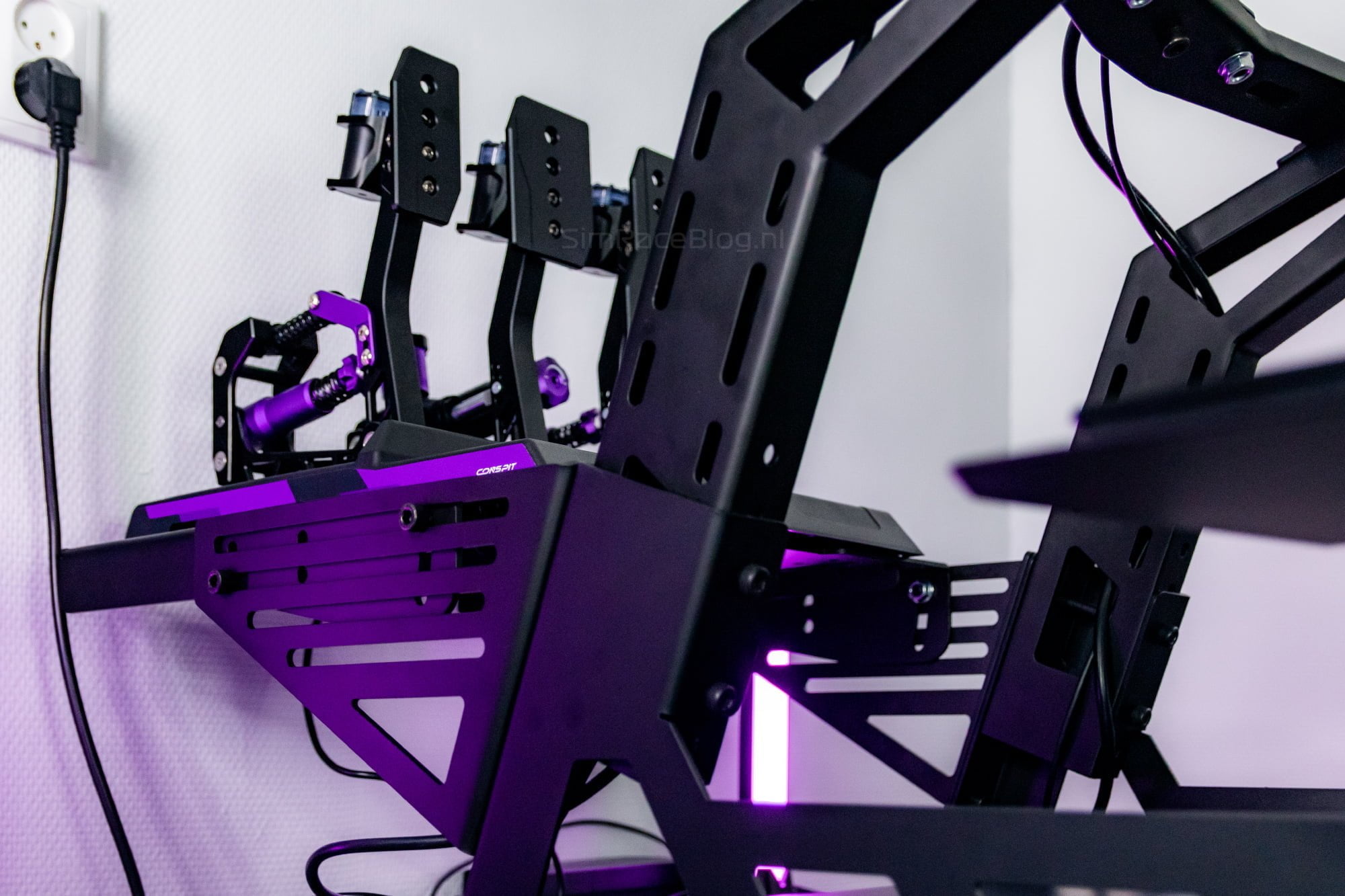
M-DVF
Before mounting the seat onto our base frame, we decided to connect the M-DVF while it was still easily accessible. The connection process is quite straightforward. The motor cable is plugged into the mode switch on the side of the seat bracket, the mode switch cable goes into the controller, and then the provided USB cable runs from the controller to your computer. To power the system, we plug the supplied power adapter into the controller and the other end into the power outlet. Here, we encountered a small issue: the provided adapter didn’t have a European plug. Fortunately, we had a travel adapter on hand, allowing us to power the M-DVF without any further complications.
Seat
Attaching the seat is a straightforward task. Since the seat isn’t adjustable concerning the brackets it’s attached to, aligning the four holes and screwing in the bolts is all that’s needed. However, due to the bracket slightly gripping the seat, we must be extra careful here to avoid damaging the seat’s sleek outer coating.
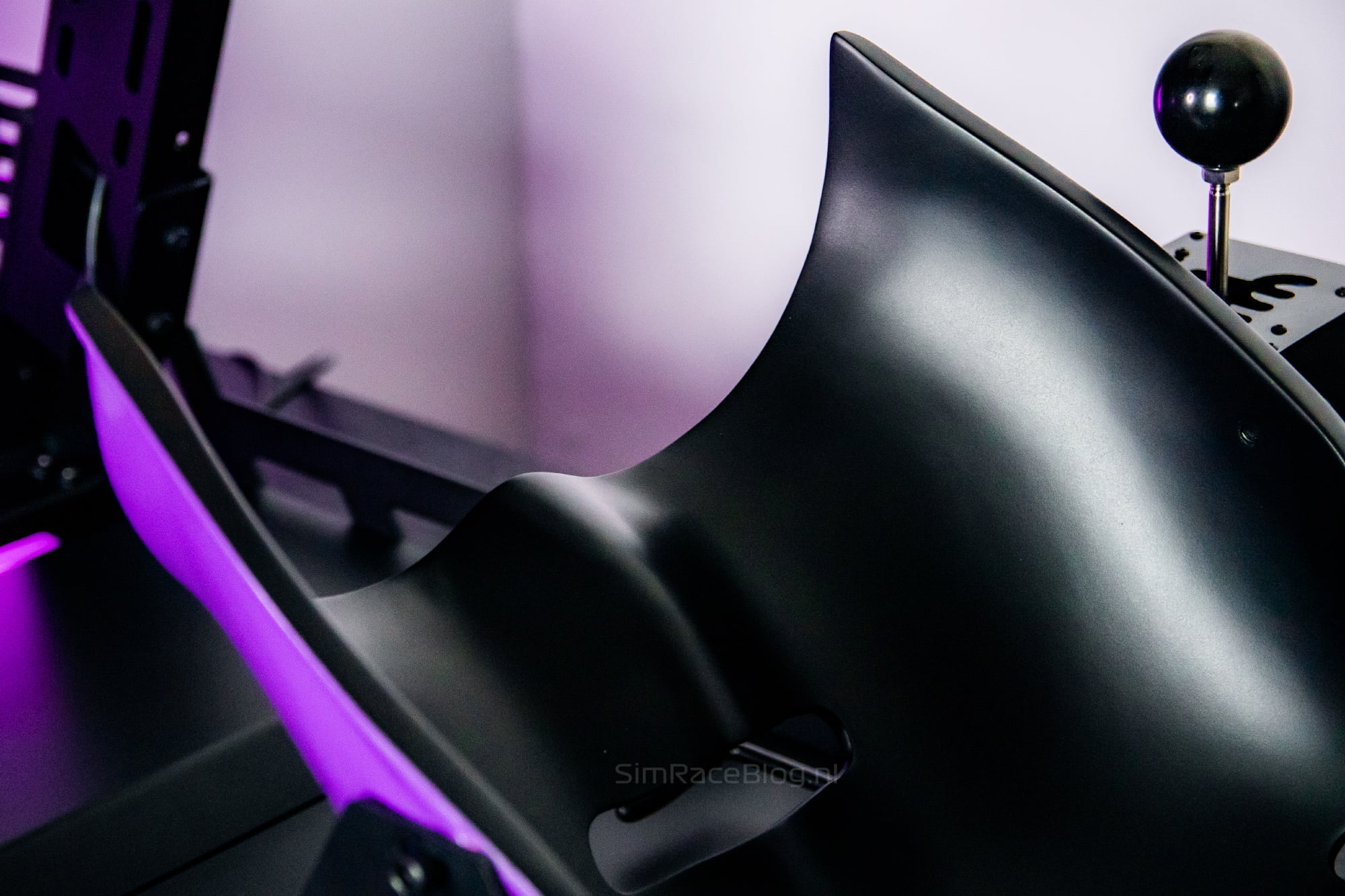

Wheeldeck
Regarding the assembly of the wheel deck, there isn’t much to say because it fits perfectly between the previously mounted brackets on the rig. By tightening the two bolts on each side, the wheel deck is secured to the rest of the frame, ready for attaching a wheelbase. As mentioned earlier in this review, the wheel deck is compatible only with wheelbases that can be attached from the bottom. Like the pedal deck, the wheel deck also features pre-drilled holes in a universal pattern. However, we had no issues with incompatible equipment; the holes in the bottom of our Fanatec CSL DD aligned perfectly with the holes in the wheel deck, securing it firmly within a minute.
Monitor stand
The last component we need to mount on the FP-Lite rig is the monitor stand. Conspit offers an optional monitor stand that can be attached directly to the cockpit. This stand is secured to the arms holding the wheel deck by means of a crossbar. It can be mounted in three different positions, allowing the screen to be positioned higher and closer to your wheelbase or lower and farther away. An additional advantage of mounting it in this location is that the rig gains some extra rigidity due to the placement of this crossbar. On this crossbar, we then attach the vertical stand and the plate to which the screen itself will be mounted. This plate features two rows of 15 holes, allowing you to position the screen at seven different heights. Please note that this monitor stand is only compatible with screens that have a 100mm x 100mm VESA hole pattern on the back. If your screen has a different size, it’s advisable to use a separate monitor stand. Since this monitor stand is connected to the wheel deck, we delay placing the monitor itself until we are certain that our wheelbase is correctly positioned for our comfort. This ensures that we can set up our racing simulator to our preferences before finalizing the monitor placement.
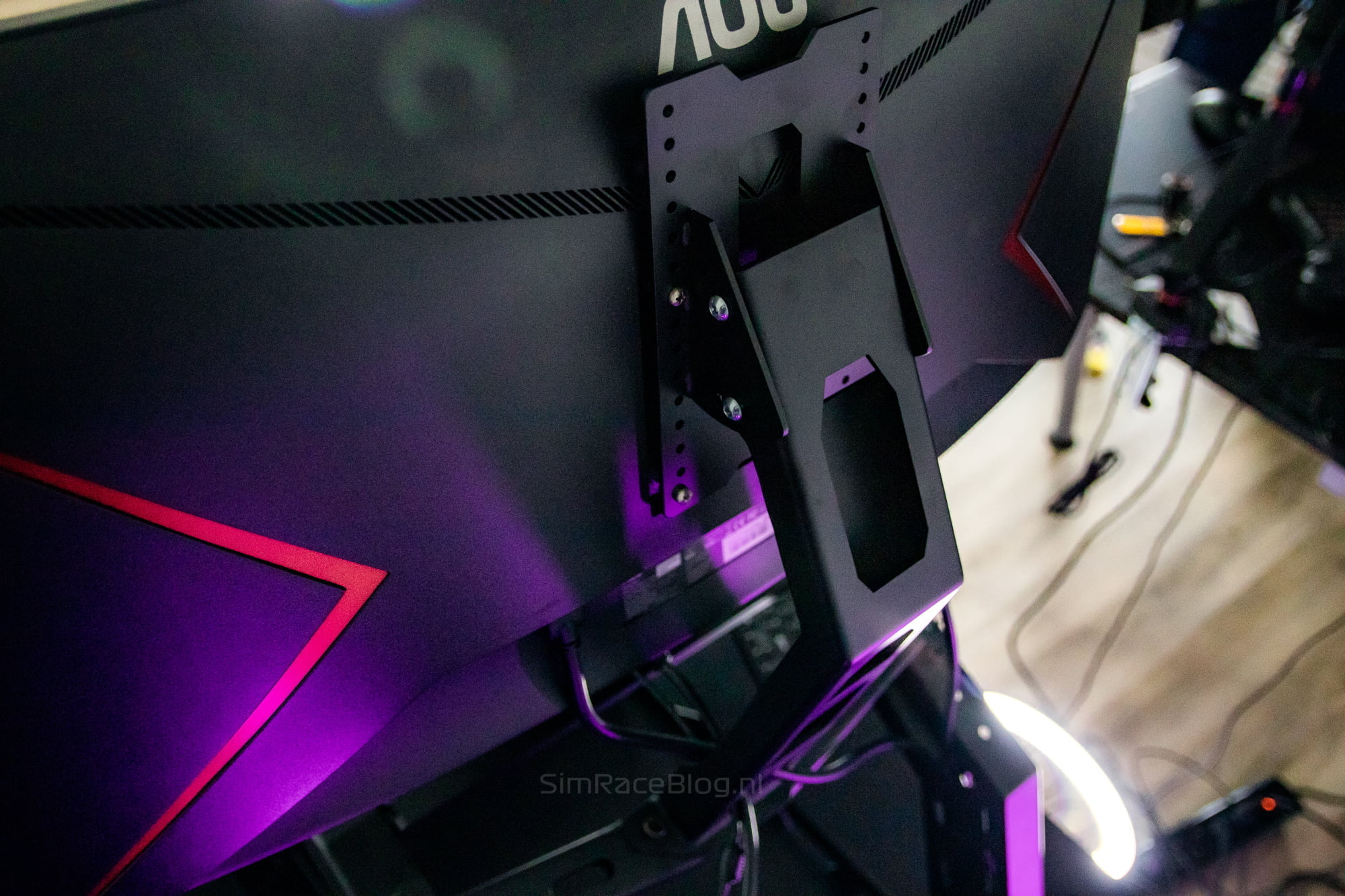
Extras
Finally, we’re left with attaching the keyboard tray and the manual bracket. Both are secured to the seat brackets using four bolts, making the process straightforward. Like the pedal deck and the wheel deck, the manual bracket also features a universal hole pattern. We mount our gear shifter on this bracket, allowing us to immerse ourselves fully in the experience of driving classic formula cars. Attaching it was a simple task because we could align all four mounting holes of the shifter with the manual bracket at multiple positions. This flexibility made the installation hassle-free.
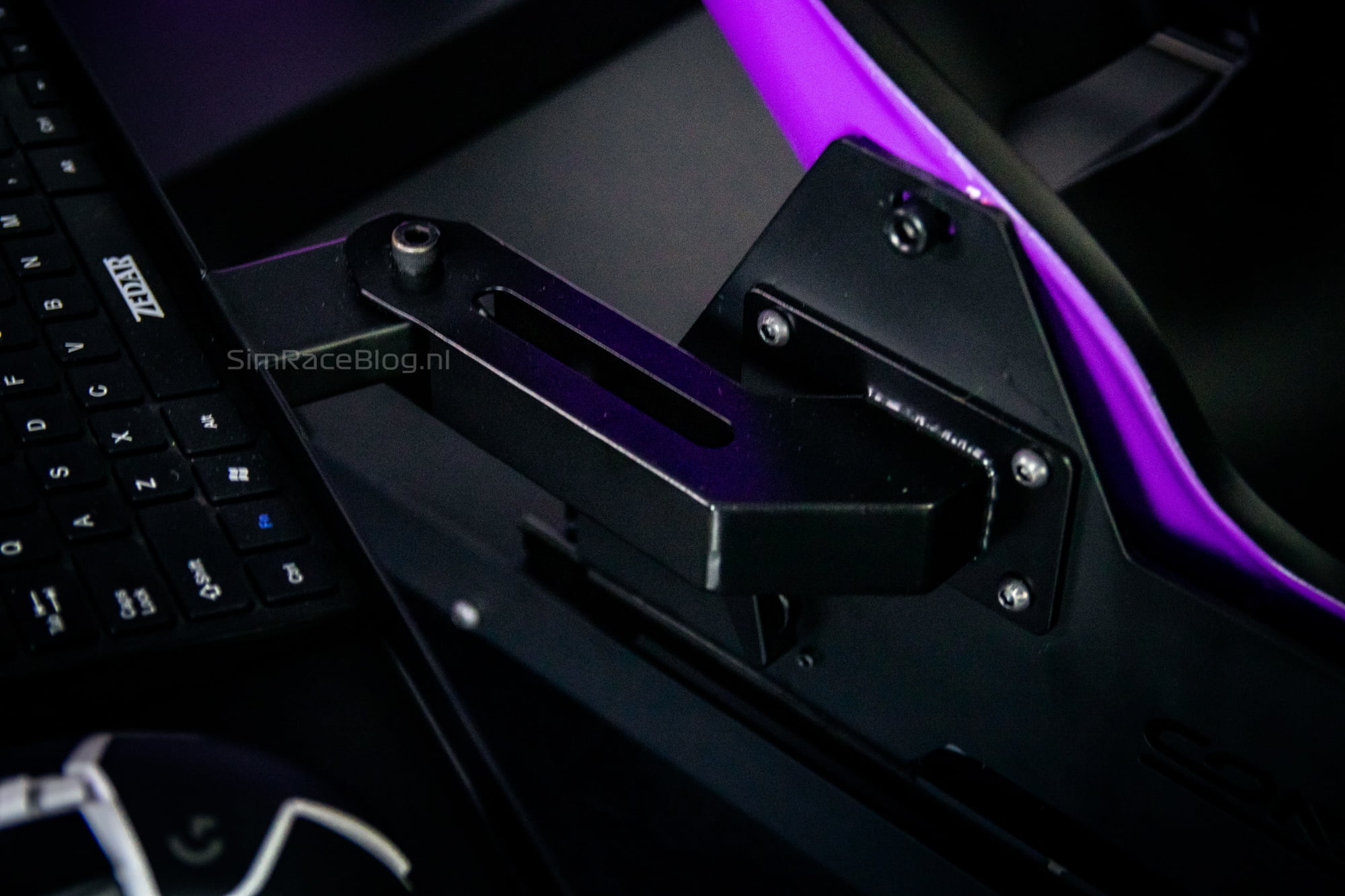
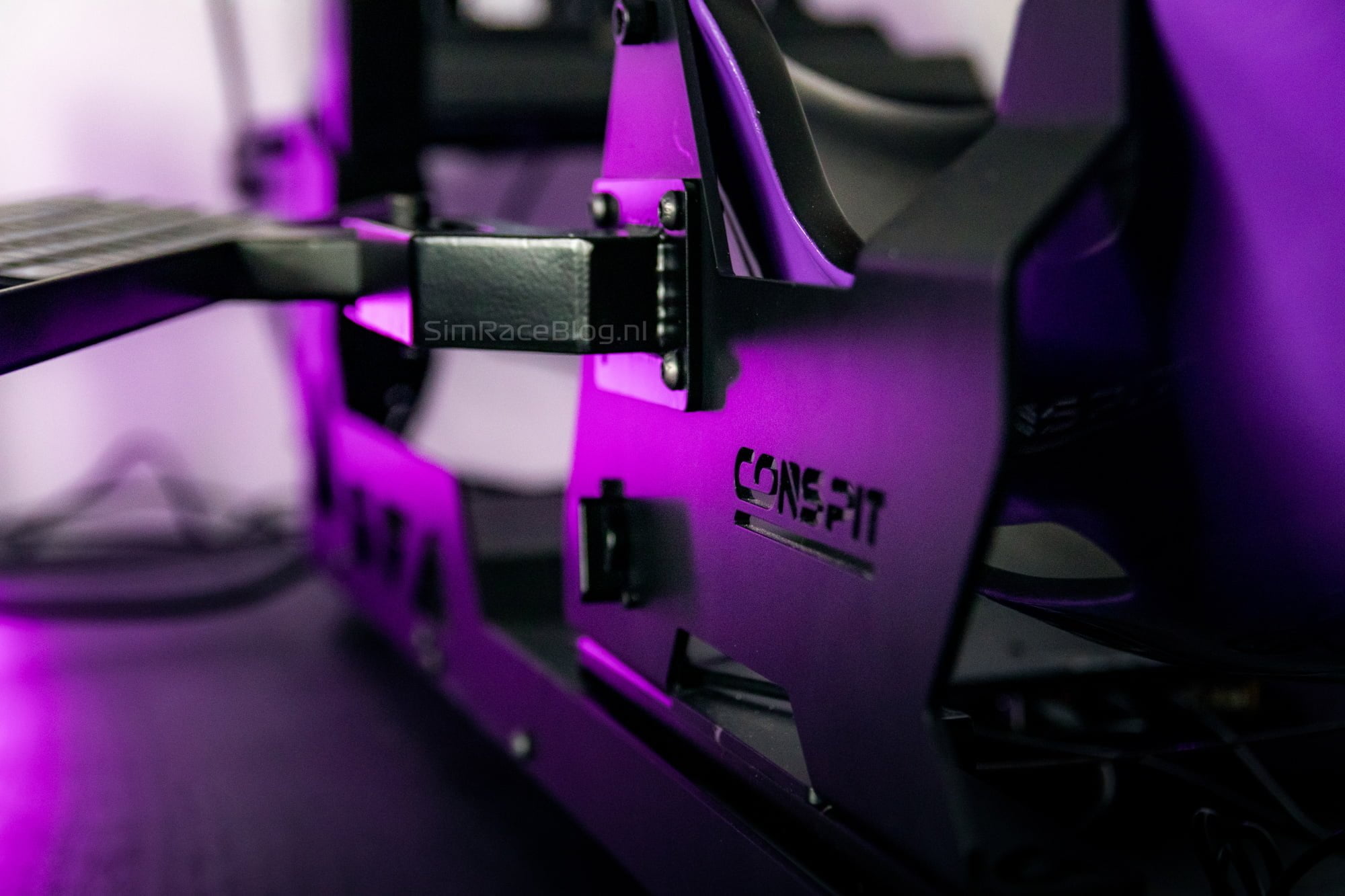
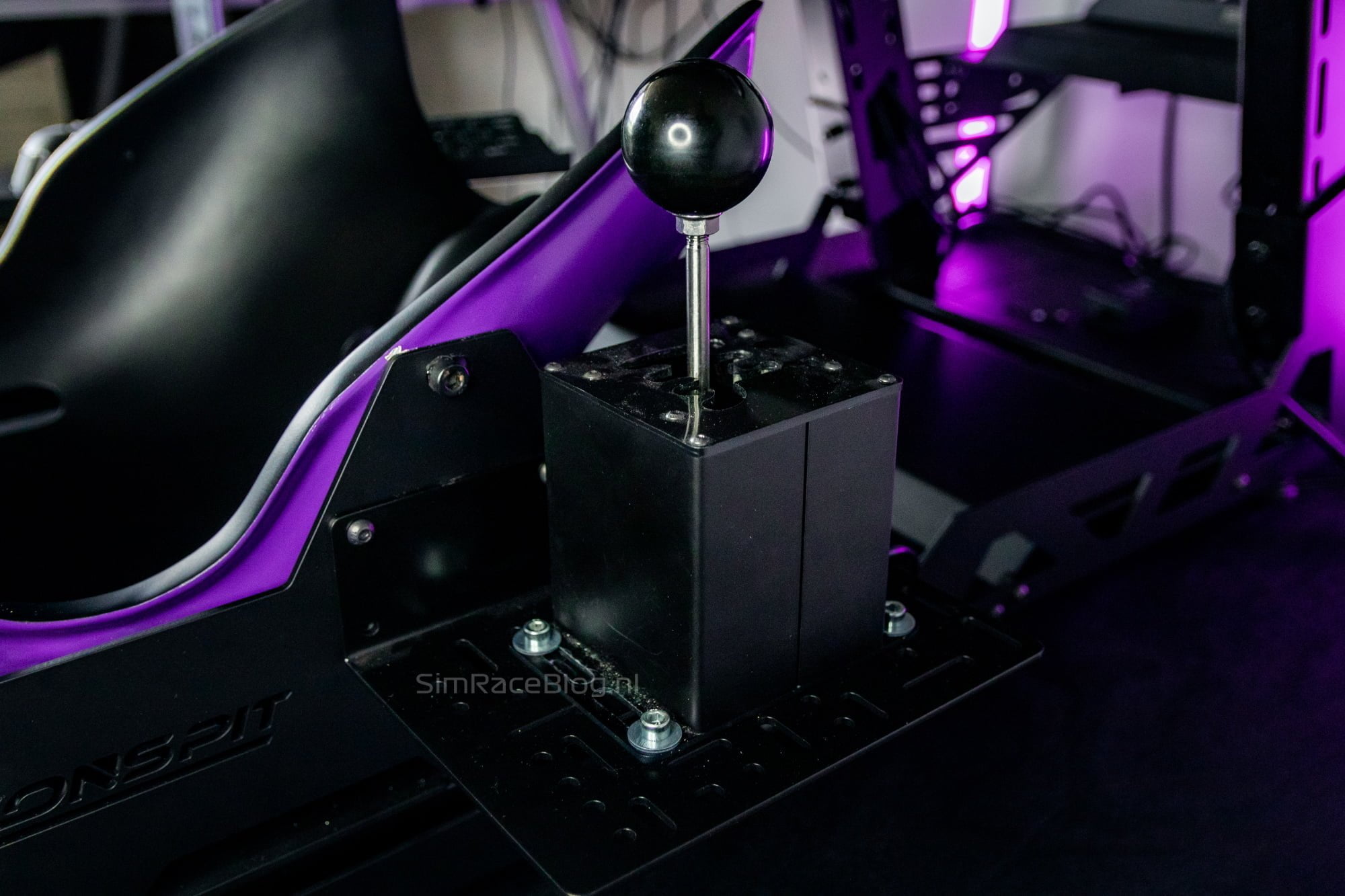
Fine tune
With all the components attached, we settle into the rig for the first time. It quickly becomes apparent that a few adjustments are needed to maximize our comfort. Adjusting a rig with a steel frame is typically trickier than one made of aluminum profiles because aluminum rigs usually offer continuous adjustability. The Conspit FP-Lite rig provides a mixed experience of continuous and incremental adjustment.
The first adjustment we make is the distance between the pedals and the seat. With our height of 1.85m, we prefer the pedals to be slightly farther back for a comfortable seating position. Thanks to the slotted system of the pedal deck, adjusting this is effortless. Loosening four bolts, a gentle push, and the pedals smoothly slide to their new position. Tightening the bolts again, the adjustment is completed with ease.
Adjusting the seat is just as straightforward. The seat attachment system operates on slides, allowing us to effortlessly slide the seat to the desired position, akin to adjusting a car seat.
The final step in achieving a comfortable seating position is adjusting the placement of our steering wheel. Here, we encounter a limitation of a rig with a fixed frame. Initially, the steering wheel is positioned too high, so we have to lower the arms holding the wheel deck by one notch. However, after mounting and tightening all the components, internal tension built up in the rig’s frame. As a result, the bolts in the wheel deck arms are securely wedged in the aligned holes even after loosening them. With some effort and wiggling, we manage to remove the bolts and lower the entire system by one notch. We have to guide the bolts back through the frame and arms before fastening them again. However, aligning the holes becomes a bit challenging due to the internal tension. To resolve this, we slightly loosen the bolts of the wheel deck, the crossbar of the monitor stand, and even the holders of the pedal deck to introduce some flexibility into the rig. After regaining flexibility in the system, we smoothly guide the bolts through all the holes and tighten everything securely.
Another point we notice when adjusting the wheel deck is that when moving it to a lower position, the wheel deck also shifted backward. This slight backward movement is due to the angled arms holding the wheel deck. Despite this, we don’t find it problematic as the wheelbase remains at a comfortable distance from us even when lowered.
With our seating position dialed in, we proceed to set up the monitor. Typically, we prefer placing the screen between the steering wheel and the wheelbase, but this isn’t possible with Conspit’s monitor stand. However, we can position the screen directly behind our Fanatec CSL DD wheelbase, which is short and compact, allowing us to keep the screen close. The monitor stand also offers multiple positions to move the screen farther or closer. Similar to adjusting the wheel deck, there is vertical movement during this adjustment. When the screen is moved backward, it also lowered. Consequently, the screen’s distance can not be independently adjusted from its height. This is a drawback of the monitor stand in our opinion. Fortunately, the monitor stand has an adjustable pivot point, enabling us to tilt the screen. This allows us to maintain a direct view of the screen despite it feeling slightly higher to us.
Finally, the only task left is to set up the M-DVF. This is a straightforward process. Upon plugging the USB cable into the computer, the motor is instantly recognized in the CONSPIT LINK software. In the menu, we can select the moments when we wanted the M-DVF feedback to activate. We have the option to enable feedback during traction control intervention, ABS intervention, wheel slip, or wheel lock. Adjusting the vibration intensity is as simple as turning the mode switch on the left side of the rig.
The use
Now that the Conspit FP-Lite rig is fully set up and ready for action, we eagerly take our seat to embark on some virtual laps. The initial impression starts with getting into the rig. It’s not the kind of rig where you casually hop in and out. You need to carefully consider how to sit and where to position your legs to take your place. Whether you see this as a plus or a drawback is a matter of personal preference. We consider it a positive aspect because it adds to the immersive experience. It feels like you’re surrendering to the seat, simulating the sensation of stepping into the cockpit of a formula car rather than simply sitting on a chair.

Despite the seat being made of hard plastic without any padding, we can confidently say it’s comfortable. Even after intense racing sessions lasting a few hours, the seat doesn’t become uncomfortable. When we climb out of our rig, we feel as fresh as when we got in, maybe with a few sweat marks as the only evidence of our racing endeavors. With a height of 1.85m and a weight of 85kg, we do feel like we’re nearing the maximum size for the seat. We have a good fit, but there isn’t much extra room. We notice that when sitting in the seat, our legs are somewhat pressed together, which can feel a bit uncomfortable at times. Fortunately, Conspit has plans to offer a slightly larger seat for the European market than the one currently available.
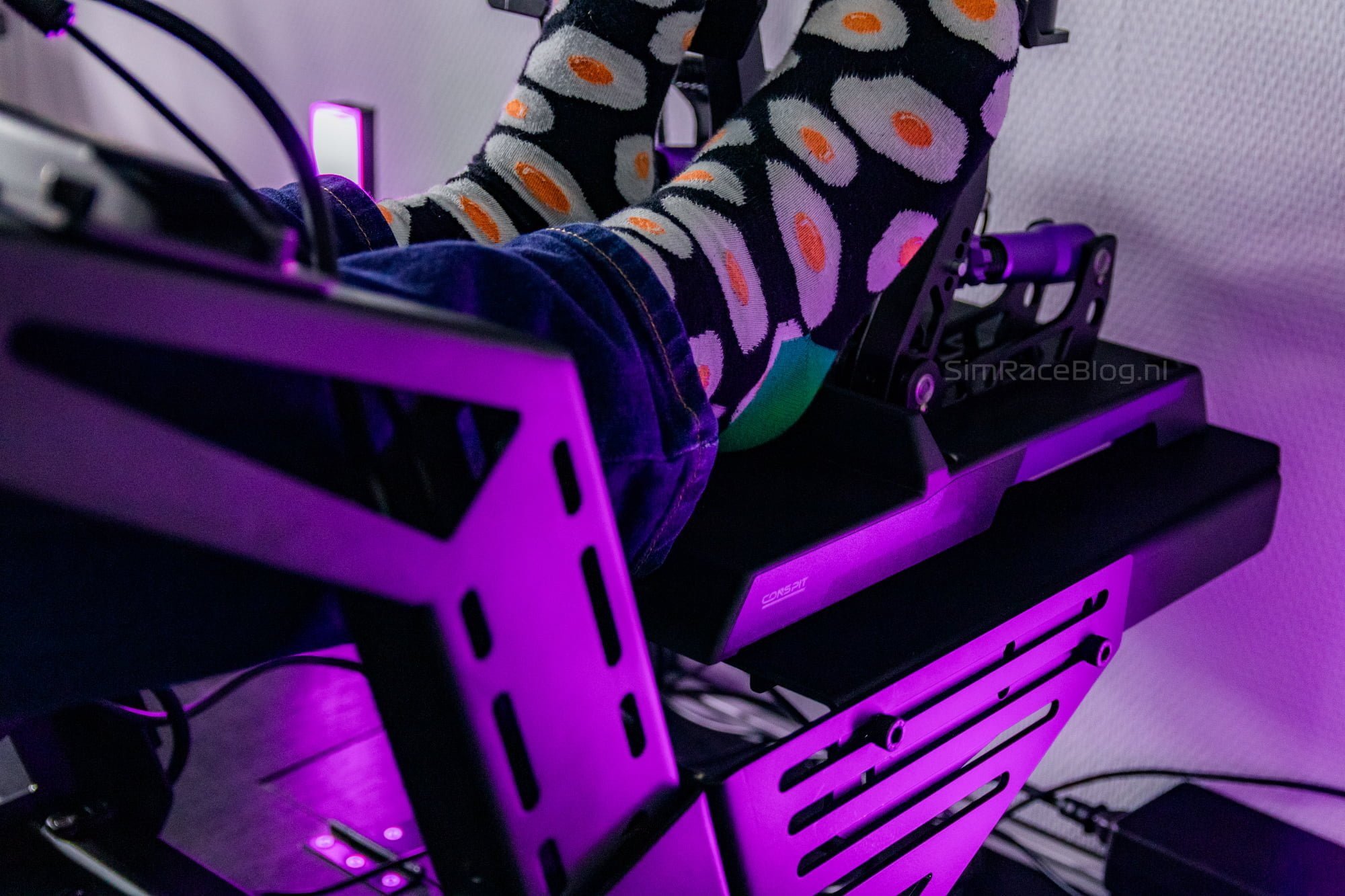
While driving, we have very few remarks about the rig. It does exactly what it’s supposed to do and appears to be very well-built. One of the aspects we always pay close attention to is the rig’s flex. Nothing is more frustrating than realizing your supposedly stable platform isn’t as solid as you hoped while racing. The Conspit FP-Lite rig absolutely does not disappoint in this regard. We quickly notice that both the pedals and the wheelbase remain firmly in place even when you’re pushing your virtual car to its limits or bouncing a bit too hard over the gravel trap. The pedal deck handles a good load cell pedal without any issues and stays firmly in place even with a hydraulic brake pedal. We are also very satisfied with the monitor mount. Attaching your monitor to your rig always carries the risk of a moving or vibrating screen during races. Throughout our testing period, we didn’t observe any distracting movements from our monitor while driving.


Nevertheless, the FP-Lite isn’t completely free from some degree of flexibility. During more intense maneuvers, we feel some lateral movement. After careful examination and trying to reproduce the issue, we realized that the flexibility seems to originate from the seat. It’s not entirely surprising, as the seat is mounted with two upright steel plates on a rail system. That being said, it’s worth noting that we don’t find this movement bothersome, and under normal conditions, the seat remains securely in place.
One of the unique features of this rig is, of course, the M-DVF system located under the seat. This system is easy to configure through the CONSPIT LINK software. In the software, you can choose when you want to experience the feedback from the motor. Unfortunately, at the time of writing, the actual firmware driver is still in a closed beta version, which we are unable to download. However, you can already test the different intensity settings of the M-DVF system via the testing feature in the CONSPIT LINK software. We test the vibration while the switch on the seat was in the first position, and then increased it through the various levels. The range of intensity settings is quite broad, ranging from subtle vibrations in the first setting to bone-rattling sensations in the highest setting. Even the sound produced by the vibrations on the highest setting can be heard throughout the house. In practice, users will likely find a sweet spot in the middle of the range where the vibrations are perceptible and the noise remains at a reasonable level.

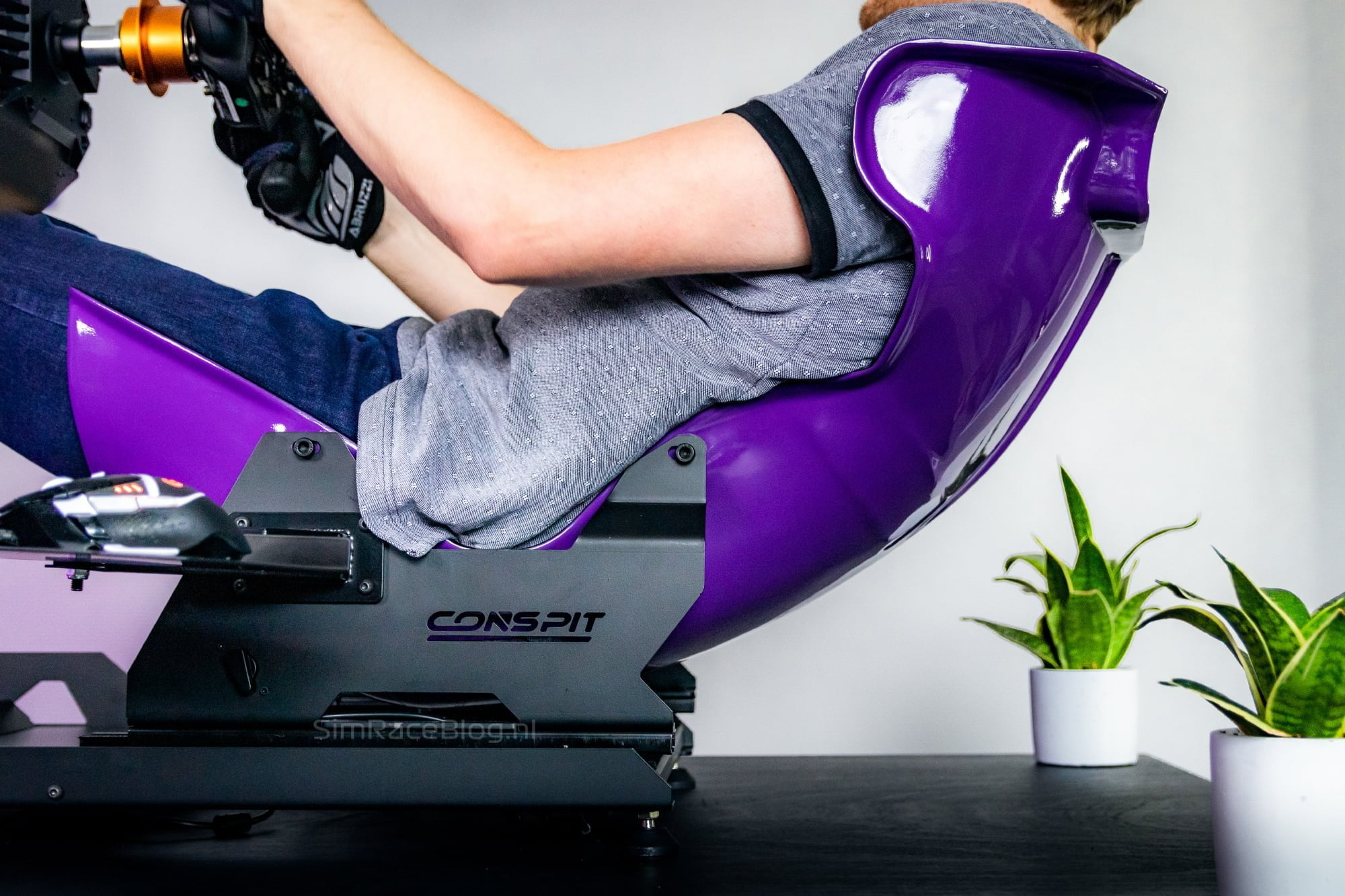
Conspit at the ADAC Simracing Expo
While writing this review, we also attended the ADAC Simracing Expo where we had the chance to meet the folks from Conspit. They had their entire range of sim rigs on display at their booth, including the new FP-lite rig. After a friendly introduction, we mentioned our struggle to get the M-DVF system up and running at home. In response, they promptly directed us to the FP-lite rig set up at their booth, so we could finally experience the M-DVF system.
Within the software, the Conspit team allowed us to choose when we wanted feedback from the electromotor. Since the haptic feedback from the CPP.Lite pedals already effectively communicated when the wheels were locking, we opted to receive feedback from the rig only when the wheels were slipping. In a Formula 1 car on the Nürburgring, we had plenty of opportunities to let the car slide around. With the M-DVF system set at its mid-range position, we found this feedback surprisingly comfortable. If we were too eager on the throttle in a turn or gave it too much gas when accelerating, we felt a pleasant vibration that immediately informed us when the rear grip of the car was slipping away. Although not a necessity for a sim rig, we found it to be a delightful addition to the FP-lite, setting it apart in a unique way from other rigs in its price range.

Video: Driving with the Conspit FP-Lite Simrig
Below is a short driving impression video featuring the Conspit FP-Lite Simrig. In this video, we’re driving with the Conspit FP-Lite Simrig equipped with our Fanatec CLS DD (8Nm), Fanatec ClubSport F1 LE 2020, and Conspit CPP.LITE pedals. For the racing game, we’re using Assetto Corsa with the RSS Formula Hybrid mod from RaceSimStudio.
Conclusion
In conclusion, we can confidently say that we’re highly impressed with the product Conspit has created here. Although we were initially taken aback by the weight of the package in which the FP-Lite was delivered, our experience with this rig has been incredibly enjoyable since then. Right from the unboxing, it’s evident that Conspit goes the extra mile to ensure the product reaches the customer’s room in the best possible condition. This attention to detail is reflected in the careful packaging, the completeness of the included materials, and the fantastic manual that guides you through the assembly process. As a result, putting together this rig is a breeze. Moreover, the FP-Lite rig is visually appealing with its matte black finish and sleek lacquered seat.
However, upon setting up the rig, we encountered a few minor issues. The universal pedal deck isn’t as universal as we had hoped, and the tension in the frame makes adjusting the wheel deck somewhat challenging. Fortunately, these are actions that generally don’t occur frequently, so these drawbacks don’t outweigh the experience of regular use. The Conspit FP-Lite rig is indeed a sturdy cockpit that exhibits minimal flex under normal conditions. Your pedals, steering wheel, and even the monitor attached to the rig remain securely in place during intensive use. The only place where we noticed some lateral play is in the seat, especially during sudden and heavier movements. However, we don’t find this to be bothersome. Despite being made of a hard material without padding, the seat provides a very comfortable sitting experience. Its sleek design might feel a bit snug for sim racers with a larger build, but Conspit has confirmed they will release a slightly larger seat for the European simreacers later on. Finally, underneath the seat, you’ll find the unique M-DVF system, which we consider to be an intriguing addition that sets the Conspit FP-Lite apart in the current market.
As of the time of writing, the FP-Lite rig by Conspit is not yet available for purchase in the European market. However, this is expected to change in the near future. Priced at €749.00 excluding VAT, we believe this rig should definitely be a serious consideration for every sim racer in search of a Formula-style rig.
Do you want to stay informed about SimRaceBlog content, news, announcements and (future) give-aways? Follow us on Instagram @simraceblognl and/or our Discord channel.











